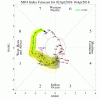GFS/GEFS has been weaker on today’s runs but NAVGEM has been trending stronger and further south with the low on today’s runs.
View attachment 4922
As Jon mentioned, the ridge over the southwestern US, Great Basin, and Rockies matters a lot here too. I'm in favor of a stronger ridge out west and deeper trough near the lakes because it's already unusually hot and dry in the western US. Warmer air is less dense, takes up more space, and the heights rise (lower) above (below) a warm anomaly which is centered closer to 700 hPa here (which means the heights rise on the height surfaces above this level).
A moderate-extreme drought blankets most of the southwestern US and south-central plains and is largely to blame for the very intense elevated mixed layers (EMLs) that keep being advected eastward into the MS valley and SE US (let's just hope we continue to have unfavorable large-scale synoptic forcing because if we get a decent pattern for severe, it's going to strengthen the mid-level capping inversion that may allow storms to remain generally more discrete than we're accustomed to and this is often a feature that's present in many of the largest tornado outbreaks in the SE US).


The forecasted z500 configuration by day 4 (ridge over the west, trough centered near the Lakes and Hudson Bay) is strongly correlated with the DJFM mean pattern, it would not be shocking to see this anomalous wave configuration grow stronger on NWP as we get closer (which is inadvertently in favor of a more suppressed wave this weekend unlike what the GFS & ICON are showing atm)

While the MJO is not in favor of this trough-ridge configuration becoming more intense, tropical forcing has not been very effective at breaking through this broad -AAM anomaly (anomalous easterlies) in the mid-latitudes and subtropics the past few months, and this MJO event is actually being dynamically forced by breaking mid-latitude waves in the NE Pacific.

Here I crudely overlaid the juxtaposition of upper level anticyclones and cyclones on the week 1 CFSv2 forecast, and overlaid the propagation vector of this train of Rossby Waves in green, which points equatorward. Notice the upper level cyclonic anomaly this wave train has created just off the coast of South America. This upper level cyclonic anomaly usually leads (or is east of) the MJO's convective envelope and if you were to extrapolate this feature to the larger-scale global pattern, it actually says the MJO is in the West-central pacific (phase 7-8) right now which is exactly what we see in the RMM phase diagrams! The creation of the upper level cyclonic anomaly over the EP will increase upper level divergence to its west over the central pacific which is what you can clearly see happening near the international dateline.



While the MJO >>>> mid-latitude pathway is more widely recognized by the meteorological community since it's a decent high frequency analogue to ENSO and was what I was taught in my synoptic class, isn't it cool to see how things operate the other way around, with extratropical waves forcing the MJO?! This new and/or temporary MJO pulse generated by the breaking extratropical waves in the N Pacific will go onto produce another series of diabatically-induced mid-latitude wave trains (or mid-latitude wave packets) that will radiate poleward and eastward at the Rossby Waves' group velocity and those waves could also propagate into the tropics and continue to sustain or even thwart the MJO through the processes I briefly glossed over above. This is why some consider the MJO to be a self sufficient phenomenon which evolves together simultaneously with the mid-latitude pattern as opposed to the more canonical one-dimensional view of the MJO forcing the wave trains and remaining unaffected by Rossby wave breaking into the subtropics.













